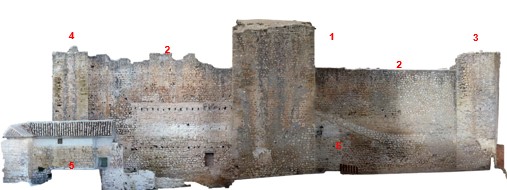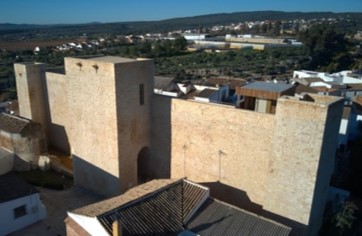CASTILLO DE HORNACHUELOS RECUPERADO COMO MIRADOR DEL BEMBÉZAR
HORNACHUELOS CASTLE RECOVERED AS A BEMBÉZAR VIEWPOINT

Foto nº1: Alzado sureste del castillo antes de las intervenciones (2017).
1: Torre del Homenaje con cámara interior ; 2: paso de ronda; 3: torre-mirador norte; 4: torre-mirador sur; 5: baluarte; 6. acceso en recodo a la plaza de armas.
Photo nº1: Southeast elevation of the castle before the interventions (2017).
1: Tower of Tribute with interior chamber; 2: round step; 3: north viewing tower; 4: south viewing tower; 5: bastion; 6. curved access to the parade ground.
El conjunto compuesto por el Castillo y el recinto amurallado de Hornachuelos es característico del tipo de asentamiento defensivo medieval, con un amplio circuito de murallas adaptadas a la topografía accidentada del terreno, con la fortaleza emplazada en un extremo de la cerca, para una más fácil defensa y salida en caso de asedio. Esta fortaleza tiene, como gran interés, la existencia de elementos singulares claramente reconocibles que pocos castillos de la zona mantienen, estos son: el paseo de ronda (adarve) transitable con gran parte de sus merlones; la puerta en recodo en la torre del homenaje y su cámara visitable; el bastión; gran parte de la braga o baluarte (torre circular); así como el aljibe en la plaza de armas y su integración o diálogo con el parcelario de Hornachuelos..
Además de contar con un circuito de murallas y torres que protegen unos 90.000 m² de superficie, algunas aún conservadas, otras fosilizadas o perdidas en su trazado. Hornachuelos se convirtió en señorío de la familia Portocarrero por privilegio de Juan II en 1444, aunque el monarca se retractó varios años después de esta decisión. Durante la guerra de Pedro I se sabe que el castillo pertenecía a Don Alonso de Aguilar, quien realizó importantes obras en la fortaleza. Aquí se libraron grandes batallas entre moros y cristianos para dominar sus preciados recursos naturales. La restauración y puesta en valor del Castillo lo ha convertido en un privilegiado mirador para sentir y fluir con la riqueza de la naturaleza y el paisaje de su entorno y la confluencia de su historia cultural, su valor arquitectónico y arqueológico.
The complex composed of the Castle and the walled enclosure of Hornachuelos is characteristic of the type of medieval defensive settlement, with a wide circuit of walls adapted to the rugged topography of the terrain, with the fortress located at one end of the fence, for easier access, defense and exit in case of siege. This fortress has, as a great interest, the existence of clearly recognizable singular elements that few castles in the area maintain, these are: the walkable promenade (adarve) with a large part of its merlons; the curved door in the keep and its visitable chamber; the bastion; much of the braga or bastion (circular tower); as well as the cistern in the main square and its integration or dialogue with the Hornachuelos plot. In addition to having a circuit of walls and towers that protect some 90,000 m² of surface, some still preserved, others fossilized or lost in their layout. Hornachuelos became a manor of the Portocarrero family by privilege of Juan II in 1444, although the monarch retracted this decision several years after. During the war of Pedro I it is known that the castle belonged to Don Alonso de Aguilar, who carried out important works in the fortress. Great battles were fought here between Moors and Christians to dominate its precious natural resources. The restoration and enhancement of the Castle has turned it into a privileged viewpoint to feel and flow with the richness of nature and the landscape of its surroundings and the confluence of its cultural history, its architectural and archaeological value.
|
Foto nº2: Vista general del castillo previo a las intervenciones (2017). Photo nº2: General view of the castle prior to the interventions (2017). |
|
Foto nº3: Vista del castillo después de su recuperación y puesta en valor como mirador del Bembézar. Photo nº3: View of the castle after its recovery and enhancement as a viewpoint of the Bembézar. |
|
Foto nº4: Planta de la fortaleza con sus elementos singulares. De izquierda a derecha: torre-mirador norte; paseo de ronda, torre del homenaje con su cámara y puerta en recodo en su interior, bastión o baluarte en la esquina derecha exterior, torre-mirador sur cuadrada; continuación paso de ronda lateral sur-oeste que cierra la plaza de armas con el aljibe. Photo nº4: Plan of the fortress with its unique elements. From left to right: north viewing tower; promenade, tower of tribute (keep) with its chamber and curved door inside, bastion in the outer right corner, square south viewing tower; continuation of the south-west lateral roundabout that closes the parade ground with the cistern. |





